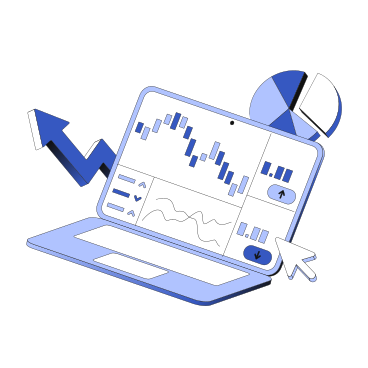In This Article
Stock trading was once an exclusive industry reserved for the elite few with wealth, connections, or direct access to financial markets. To get in, you often needed to be physically present on Wall Street or have a good relationship with a high-level broker, making it a world out of reach for everyday people.
But today, thanks to the internet and the rise of digital trading platforms, this once-guarded world is at our fingertips, easily accessible to the general public. You only need a computer or smartphone to access global markets, trade stocks, and build your investment portfolio, whether at home or on the go.
With so many ways to trade stocks, it’s important to understand the options available and how they suit different investor profiles while choosing the right trading strategy based on your goals and risk level. In this article, we’ll explore five popular stock trading methods, breaking down the pros and cons of each to help you find the best fit for your investing style.
Quick Overview

For beginners who are looking into stock trading, here are some of the most popular instruments to trade stocks, along with a brief overview of each:
- Equities (Stocks): These are individual stocks where you buy shares in a specific company. Companies pay dividends to shareholders, and investors can profit from selling stocks at a higher price than what they paid to acquire them.
- Exchange-Traded Funds (ETFs): They offer diversification and lower expense ratios, making them one of the low-cost trading options. It actually trades like stocks throughout the day, offering flexibility to investors.
- Direct-Stock Plan (DSP): A company offers a plan that allows its employees to purchase its stock directly from the company, often at a discounted price, without paying any brokerage fees.
- Futures Contracts: Give you greater leverage and let you control a larger portion with a smaller investment. Trading with futures contracts carries a higher risk as it allows you to achieve maximum leverage, and there’s always a potential for rapid price movements.
- Options Contracts: You can trade assets with options contracts at a specific price bracket. Although this offers leverage, it can also be more risky.
- Commodities: These include the trading of physical assets like gold, oil, wheat, and other similar items, which allows diversification in a portfolio. Prices fluctuate and stay volatile depending on supply and demand.
- Bonds: This trading option offers regular interest payments, also known as fixed income. Its prices fluctuate based on interest rates, and it has a fixed maturity date.
1. Direct Stock Purchases (DSPs)
Direct Stock Purchases (DSPs) allow investors to buy company shares directly without going through a broker. Many companies offer Direct Stock Purchase Plans (DSPPs), which transfer agents facilitate. These plans enable investors to acquire shares at discounted prices while bypassing brokerage fees, often making them more affordable for long-term investors.
Pros
- No Brokerage Fees: With DSPPs, investors can avoid the fees charged by traditional stockbrokers, allowing them to invest more capital directly into stocks.
- Dividend Reinvestment: Many DSPs can automatically reinvest dividends, compounding returns over time without additional cost.
- Long-term Growth: Direct stock purchases are ideal for long-term investors wishing to build a company portfolio gradually.
Cons
- Limited Liquidity: Selling shares through DSPs can be less flexible than using a broker, often requiring additional paperwork and delays.
- Limited Access: Not all companies offer DSPPs, and investors are limited to buying shares only in companies that do.
- No Diversification: Direct stock purchase focuses on individual stocks, increasing the risk of lack of diversification if the investor doesn’t hold shares in multiple companies or sectors.
2. Exchange-Traded Funds (ETFs)
Exchange-traded funds (ETFs) are collections of stocks or other securities that track an index, sector, or other market segment. They allow investors to buy and sell units just like regular stocks on an exchange. ETFs are popular because they offer exposure to a wide range of assets with the convenience of stock trading.
Pros
- Diversification: By investing in an ETF, you gain exposure to multiple stocks or securities, reducing the risk of holding a single stock.
- Liquidity: These funds are traded on major stock exchanges, offering high liquidity. Investors can buy and sell shares during market hours at real-time prices.
- Low Fees: Compared to actively managed funds, ETFs typically have lower expense ratios, making them more cost-effective for long-term investors.
Cons
- Market Risk: While ETFs offer diversification, they are still subject to overall market volatility, meaning losses can occur if the broader market declines.
- Tracking Errors: Some Exchange-Traded Funds may not perfectly track the performance of their underlying index, leading to slight deviations in returns.
- Limited Control: Investors don’t have control over the specific stocks held within the ETF, as they are managed passively to track the index.
3. Contract for Difference (CFD) Stocks Trading
Contract for Difference (CFD) trading allows investors to speculate on stock price movements without owning the underlying asset. When trading CFDs, investors enter into a contract with a broker like NordFX, agreeing to exchange the difference in the stock’s price between the opening and closing of the trade. This trading offers the opportunity to profit from both rising and falling markets.
Pros
- Profit in Both Directions: You can profit from rising and falling stock prices with CFDs. If you believe a stock’s price will decline, you can sell (short) and profit if the price drops.
- Leverage: It allows for margin trading, meaning you can control more significant positions with less capital, amplifying potential returns.
- Access to Global Markets: Brokers offer access to a wide range of stocks from global markets, allowing traders to diversify across international assets.
Cons
- Overnight Fees: Holding CFD positions overnight often incurs fees, which can add up over time and reduce overall profitability for long-term positions.
- Market Volatility: These trades are highly sensitive to market volatility. Sudden market swings can cause quick losses, especially when using high leverage.
- High Risks: Although leverage can potentially increase profits, it can also amplify losses. A small market movement against your position can lead to significant losses.
4. Mutual Funds
A mutual fund is a professionally managed investment vehicle that pools money from multiple investors to buy a diversified portfolio of stocks, bonds, or other securities. Each investor owns shares of the mutual fund, representing a portion of the holdings. Mutual funds are typically used for long-term investment strategies and are managed by professional fund managers.
Pros
- Professional Management: Mutual funds are managed by experts who analyze markets and make investment decisions on behalf of the investors, relieving individuals of this responsibility.
- Diversification: By investing in a mutual fund, you gain exposure to a wide array of assets, reducing the overall risk compared to investing in individual stocks.
- Accessible to Beginners: Mutual funds are ideal for novice investors who want a hands-off approach to building a diversified portfolio.
Cons
- Management Fees: Actively managed mutual funds often have high expense ratios and management fees, which can reduce returns over time.
- Lack of Control: Investors don’t have direct control over the fund managers’ investment decisions, making this option less flexible for active traders.
- Low Liquidity: Unlike ETFs, mutual fund shares are typically only priced once daily, meaning investors can’t trade them during market hours and may face delays in executing buy or sell orders.
5. Direct Market Access (DMA)
Direct Market Access (DMA) refers to the ability of sophisticated investors to place trades directly on stock exchange order books. This method provides more control over trades, enabling investors to execute their buy and sell orders without intermediaries, such as brokers, taking over the execution.
Pros
- Complete Control: Investors using DMA can directly control their orders, deciding their trades’ exact price and timing.
- Faster Execution: Since Direct Market Access bypasses intermediaries, orders can be executed faster, often at more favorable prices.
- Greater Transparency: Investors can see the entire order book on exchanges, giving them insights into the supply and demand for a stock at different price levels.
Cons
- Complexity: DMA trading is more suited for experienced investors and traders who deeply understand how stock exchanges and order books operate.
- Higher Costs: While DMA offers faster execution, it often comes with higher fees, especially for retail investors.
- Limited Availability: Not all brokers offer DMA, which may only be available to institutional or professional traders.
Concluding Thoughts
In today’s digital age, stock trading has evolved to offer a wide range of options, each catering to different investor needs. From Direct Stock Purchases and ETFs to more advanced methods like CFD trading and DMA, it’s easier than ever for individuals to take control of their financial futures.
By exploring these five popular stock trading methods, investors can choose the best trading instrument with their goals, risk tolerance, and experience level. Each method has its own pros and cons, so the key is finding the right balance between control, cost, and risk.











